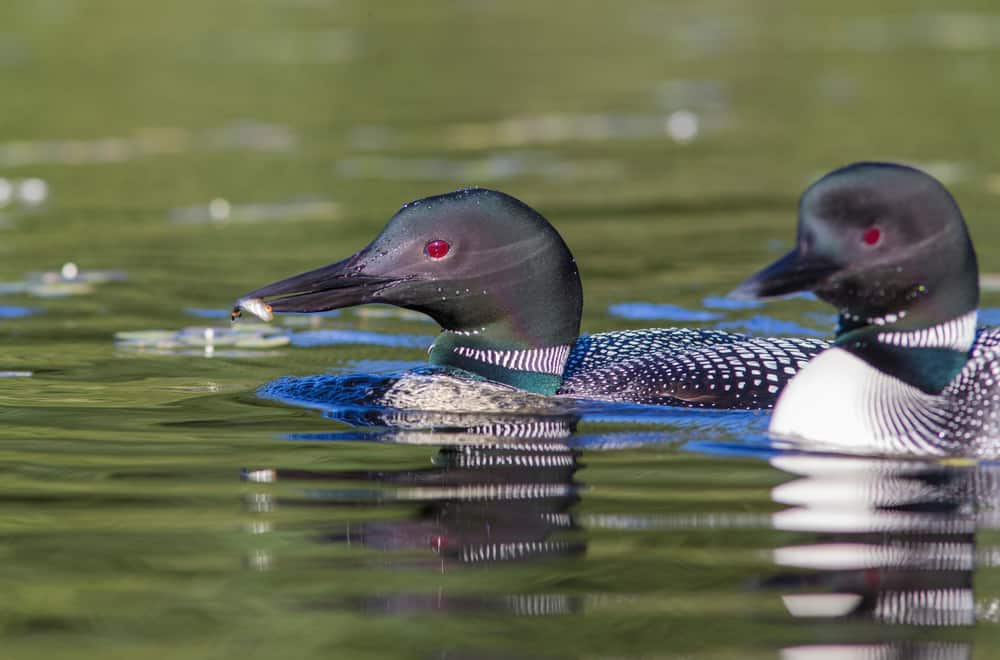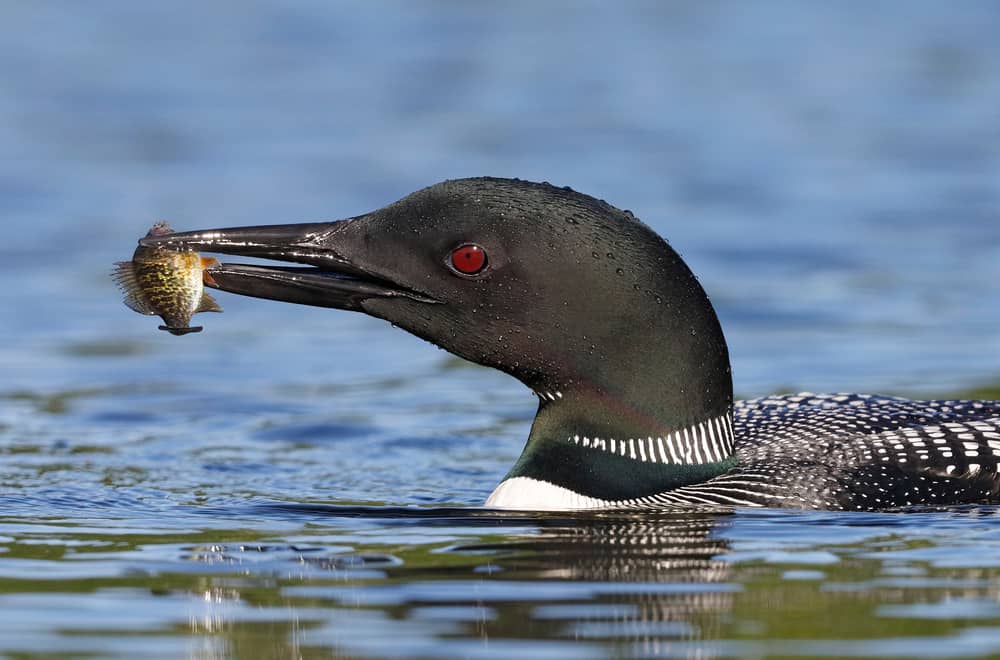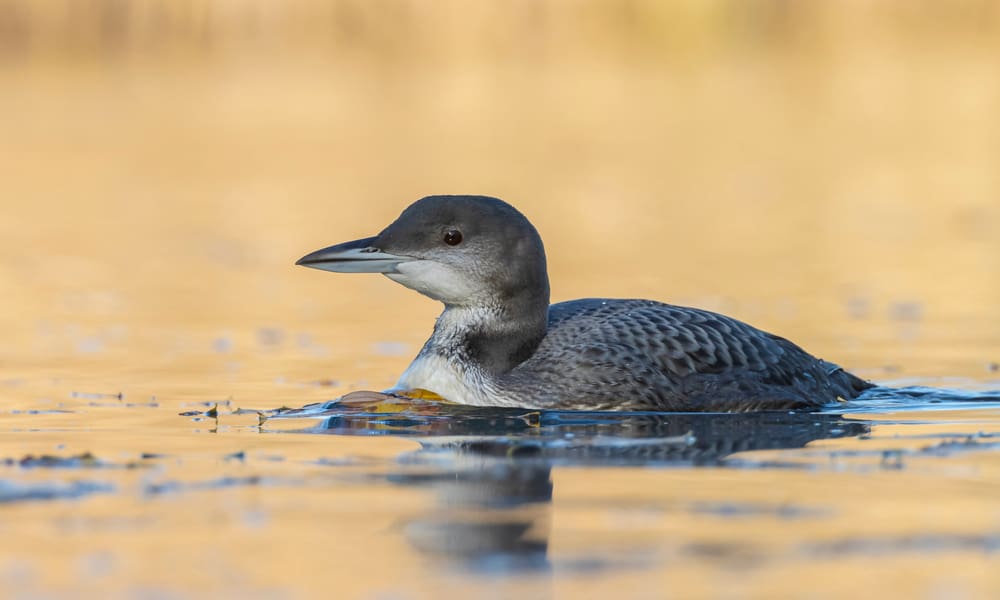A lot of bird lovers want to know what do loons eat. These birds are somewhere between ducks and geese in terms of their size. They spend most of their time on and around the water, hunting and socializing with other loons. The animal has webbing on its toes, which helps with swimming.
Loons Habits and biology

Loons spend most of their time in lakes and rivers. They use their feet to submerge their bodies or get out of the water. Although these feet are crucial for hunting, they cause a lot of trouble on the ground. Loons cannot walk well, and they avoid getting out of the water. You will only see them on the ground when they’re injured or building a nest.
Besides their toes, it is worth mentioning loon’s beak. They use it to catch fish, but it can also serve for stabbing. There are instances when loons managed to kill much bigger birds with their beak (for example, eagles).
Loons can fly, but they’re not good at it. Their wings are very heavy compared to their size, which causes problems during takeoff. To circumvent this problem, loons run on the water, thus gaining enough lift to take off. The only exception is the red-throated loon, a subspecies that can take off from the ground.
While it takes them some effort to get off, once in their air, they are great flyers. According to scientific data, the animal can fly up to 1080 kilometers in one day. When migrating, loons mainly fly from South Baltic to the Mediterranean or the Black Sea.
Here are some of their interesting habits:
- Loons are not that social. For the most part, they will spend their days alone. However, they might sometimes group up together during the night when they want to go to sleep.
- Similarly, the animal migrates alone. Only on rare occasions will you see them grouping up with other loons.
- The species has very strong bones, which sets them apart from other bird species. As a result, they are much better divers. Loons can exhale air from lungs and make their feathers flat, thus removing all the air from plumage. This allows them to submerge quickly.
- Small chicks love being on their parent’s back. They will spend the first 7 to 10 days there.
What do loons eat in the wild?

These birds are heavily relying on their sight to track and catch prey. Given that they’re amphibious animals, it isn’t surprising they mostly focus on fish. But they will also eat various crustaceans, amphibians, and other similar aquatic animals.
Loons like to hunt in lakers with clear water. This gives them a better oversight of the water body. By relying on their bills, they can catch and pierce just about anything. The bird eats their prey whole.
The bird eats things that are up to 10 inches long. Here are some of the species they eat:
- Perch
- Suckers
- Minnows
- Rock cod
- Killifish
- Gizzard shad
- Mollusks
- Frogs
- Leechees
- Snails
- Crayfish
- Various insects
Loons swallow pebbles found on the bottom of the lake or river as a way of improving digestion. According to experts, the bird uses them to crush bones and the exoskeleton of their food. Pebbles also help with indigestible food and regurgitation.
Loons can eat fish that weigh from 10 to 80 grams. In most cases, they will swallow the food while underwater, but they might bring it to the surface if they have to feed chicks. An adult animal needs about two pounds of food every day.
So, given that an average animal weighs between seven to nine pounds, a loon can eat 22% of its weight every day. Small chicks are even more voracious, being able to eat 40% of their weight a day. All in all, the animal has very high nutritional requirements.
Like many other animals, this bird gets some energy from sunlight. In addition, it gets a lot of minerals, vitamins, and proteins from its food. The bird especially relies on fats and proteins as it needs enormous amounts of energy to maintain temperature, fly, and dive.
Unfortunately, due to the bird’s voracious nature, it isn’t uncommon for them to ingest pellets and hooks left behind by hunters and anglers. There were a lot of cases of lead positioning due to these objects. As a result, various governments have prohibited the use of these shots and sinkers. The list includes Vermont, Maine, New Hampshire, Great Britain, Michigan, Denmark, and Canada.
13 Facts about loons
In many ways, loons are unique for bird species. Here are some of the most interesting things about this animal:
- Loons are one of the best bird divers. They can go all the way down to 200 feet below the surface. Due to their strong bones, they are much less buoyant than some other species. So, there won’t be anything pulling them upwards when they dive.
- On average, the bird will be underwater for about 90 seconds. However, they can remain there for up to eight minutes.
- A picture of a loon can be found on Canadian coins. These are also called “loonies,” coins with an image of the bird on its backside. When the Canadian government made the coins in 1986, they used Queen Elisabeth for the face. Unfortunately, as Canadian mint was making them, they lost their canoe dye. To avoid stoppage of production, the mint decided to use a picture of a loon. Today, Canadians consider these coins lucky.
- As mentioned, the loon’s legs are not ideal for walking. They will stumble a lot when on the ground. In fact, they often push themselves around on their bellies.
- When laying eggs, a pair of loonies will create a nest on the ground. However, they will try their best to find a position as close as possible to the water. Islands are ideal for building a nest as they are far away from potential predators.
- Loons can fly very long distances. Their maximum flight speed is at around 70 miles per hour. Unfortunately, getting off the ground is a major problem as loons have to be on the water and flap their wings to take off. They need at least 100 feet of a “runway” to start flying. If we’re talking about heavier loons, they might even have a longer track, about a quarter of a mile, to take off.
- Loons use various calls to communicate with each other. Each one of them is suitable for a specific situation. By releasing wailing haunting bellows, they give up their position to faraway rivals and mates. Repetitive shrieking is used to warn intruders not to trespass. The birds also use a cackle that is common when the animal becomes territorial or feels threatened. Lastly, we have a hoot that loons exchange between family members. By hooting, the bird tries to stay in touch with nearby chicks, parents, and mates.
- During the winter months, the loon’s eyes are gray. When the spring comes around, they will become red. According to experts, this probably has to do with underwater vision. Alternatively, it might be an evolutionary trait that helps them attract partners.
- As they are very similar to ducks, people often mistake them for this species. However, all the scientific data indicates that these animals are relatives of albatross and penguins.
- Due to their heavy bones, loons will be much deeper in the water as they’re swimming.
- Unlike many other bird species, loon chicks like to ride on parents’ backs. A baby will spend around 65% of its infancy riding its parent’s back. Besides the fact that this keeps them warm, it is also a great way to protect them from aquatic predators.
- Male loons will remain with females for a longer time after hatching. The pair will share parenting responsibilities for two to three months. Once a chick becomes capable of flying, it will separate itself from its parents and live its own life.
- Although not that common as geese or ducks, loons are popular in various countries of the world. Mercer, Wisconsin, calls itself the “Loon capital of the world,” and some other cities utilize the bird’s popularity to advertise its tourism. If we’re talking about Mercer, in particular, the citizens treat loons in an endearing way. There is even a 16-foot statue of a loon in front of the city’s chamber of commerce. On top of that, the city authorities hold a “Loon Festival” every year. During the festival, citizens and visitors dress and birds, make bake sales and paint their faces in various colors. There is also a loon calling contest where participants will try to replicate the sounds of wild loons.
Summary
Loons are one of the less social bird species. Even when migrating, they don’t have a habit of pairing up with other loons. Nevertheless, they are great flyers and divers. Their legs are not ideal for walking, so they try to remain close to the water surface.
The animal’s diet mainly consists of fish and other species found in lakers. The animal gets most of its food by diving up to 200 feet in the water. Sometimes, they will also take pebbles from the lake’s floor and eat them to improve digestion.
